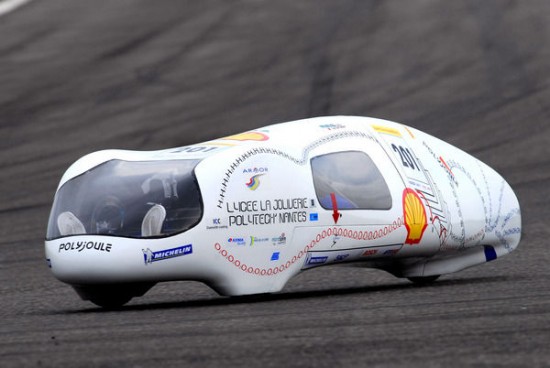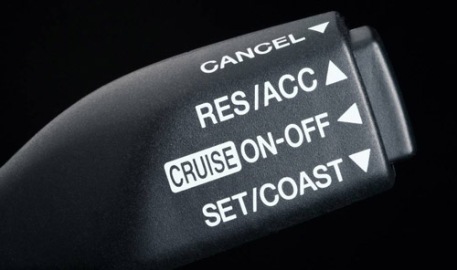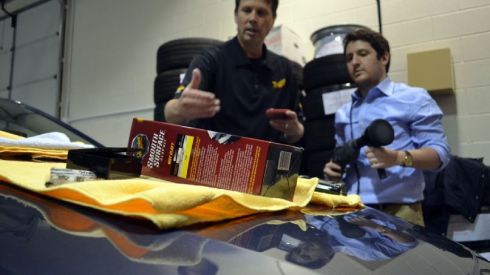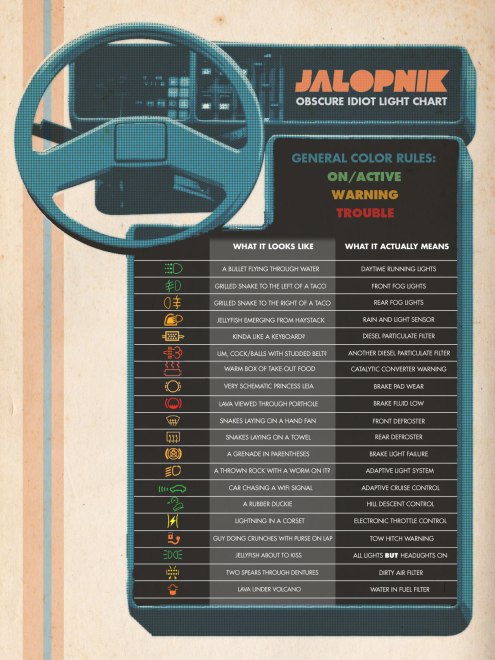Guide To The Most Confusing Warning Lights
Warning Lights have been in cars an awful long time — basically, since that moment someone realized it’d be cheaper to just have a little bulb come on when everything was going to shit instead of having a gauge that would warn of imminent shit-goings. Modern cars have more than ever, and many have bewildering symbols. So, here’s a chart of the 20 most confusing ones.
Most dashboard warning lights are identified with symbols as opposed to actual text. This is so an international, language-independent standard can be established, and to avoid warning lights six inches long that read CATALYTIC CONVERTER SYSTEM TEMPERATURE WARNING and stuff like that. Conceptually, this isn’t a bad idea at all, but it does mean that a lot of warning lights have arcane, confusing hieroglyphics that look like snakes dancing around someone’s lunch or something.
Via Jalopnik
Off-Roading 101: Enhance Your Experience
source: WebOffRoad
Road Rage: Adding Insult to Injury

Find more great infographics on NerdGraph Infographics
Car Facts
Most gas gauges have an arrow pointing to the side of the car that the tank is on.

Warranty “Problem” Stories – and Advice – From a Retired Factory Rep

by Steve Lehto
If you don’t change the oil in your new car, the engine will explode. I interviewed a retired factory field engineer to hear about how often that happened, and other warranty “problem” stories from the manufacturer’s side.
I’ve known Dave (not his real name!) for more than a decade. He handled claims in a different part of the country from where I practice and somewhere along the line our paths crossed and we became friends, even though my job as a lemon law attorney was kind of the opposite of his. I asked him for some of the more memorable cases from his 30+ years of handling warranty claims for a national manufacturer. I cherry-picked a few he told me about.
A woman filed a claim on the van she owned with her husband, complaining of a noise which no one in the service department could hear. Dave was asked to inspect and report back to the manufacturer. After riding in the van and not being able to hear anything, he pulled the husband aside and asked him if to describe the noise to Dave. The husband lowered his voice, “Man, I ain’t heard it either. But she’s my wife and I gotta back her up on this one.”
Another time, Dave was called when a customer complained about a dealer wrongfully denying warranty coverage for her van. When Dave went to look at the van, he saw that the rear bumper was caved in. He asked her, “How can I help you?”
She pointed at the bumper: “There.” She had backed up in a parking lot and had run into the cement base of a light pole. “That should be warrantied.” When asked why the manufacturer ought to pay for the damage, she said that the vehicle “was supposed to have five mile per hour bumpers, and I hit it at less than five miles per hour.”
Another customer complained when the dealer suggested his crushed roof wasn’t covered by warranty. When Dave saw the car, he could still see footprints visible on the hood of the car where someone had jumped on the hood, walked to the roof and jumped up and down on it a few times. The customer said that the damage had occurred while he was in church and his fellow churchgoers were too honest to have done something like that.
One woman came in with a car that was out of warranty but the paint was coming off in sheets. Dave decided it would make sense for the manufacturer to pay for the paint job out of goodwill. She accepted. A few weeks later, Dave stopped by the shop and was told that the job had just been started but the customer’s “representative” was there to “talk to him” about the repair. Dave went to the conference room and was greeted by a hulking man who looked like a marine drill instructor – because he was one. He demanded to know why the customer had not been given a rental car and without waiting for an answer, suggested Dave was intentionally mistreating the customer.
A little bothered by the fact that the customer had not asked for a rental – which he would have given her if she had asked – and that the “representative” likewise had not asked, Dave told him. “She never asked for one.” Rather than picking up on the hint and simply asking for one, the man leaned in close to Dave’s face and began berating him for how poorly he treated his customers. Dave let the man vent and then left. No rental car was given. The free paint job was however, primarily because the job had already begun.
One customer complained about how the warranty claim had been denied on her vehicle’s transmission. The car was out of warranty so Dave was called. The dealer told Dave that the woman was a good friend of one of the dealer’s employees. The two sat down and the woman launched into a tirade about what a piece of junk the car was and how she was never going to buy another car from that manufacturer ever again. After insulting the manufacturer and its products for a few minutes she caught her breath and demanded that Dave authorize the post-warranty repair.
“Ma’am. Could you give me any solid business reason – after you telling me you would never buy our product again – for me to extend any help to you?”
She had no answer. Dave declined to give her the goodwill repair – which he probably would have given to her if he had thought it might help keep her as a customer. A few days later the husband called the dealership to find out what happened. When he was told the repair was declined he responded, “Don’t tell me she opened her mouth?!”
One customer complained that several of the controls in her car were hard to operate and the center console in her vehicle could only be accessed if she unbuckled her seat belt and moved around. Dave got in the car and found that he had no problem working the controls or accessing the console when he sat in it. The customer came back to talk to him and he realized what the problem was: She was substantially, how do we put this, larger than Dave was. This customer had filed a claim with the manufacturer and Dave had to write a report of his findings. After determining that there was nothing wrong with the situation except for the way the client fit into the car, he submitted his report and noted the customer’s “girth” as being the primary factor. But it was not a problem covered by warranty.
A short while later, Dave was asked to write an apology letter to the girthy customer who had taken offense for having her girthiness noted in Dave’s report. Dave had been careful to not criticize the customer and asked how such a thing could have been addressed otherwise. The proposed language was, “The interior dimensions of the vehicle do not match the exterior dimensions of the customer.”
One of the most common things Dave saw was engine failures where the customer had not properly changed the oil – sometimes with cars coming in with their factory-installed oil filters still in place. One customer told him it was a factory-defect and she was certain: Her last two vehicles had the same problem with their lousy engines and for some odd reason the company kept trying to blame her.
Dave told me, “I couldn’t even count the number of times – hundreds of times – where people didn’t change their oil.” One time, another factory representative drove his executive car for 35,000 miles without changing the oil and the engine failed. And on those cars, the oil changes were provided for free. The warranty claim was denied and a dealer was paid retail to replace the engine.
Not all the cars came back in with the factory filters still in place but they often came in at 40 or 50 thousand miles with sludge-filled engines. Because it is theoretically possible for other causes to lead to a sludge problem, dealers routinely ask to see receipts or records for oil changes to prove that they were performed. It was extremely rare for the customer to have evidence of the oil changes. One customer filed a small claims action and brought to court a whiteboard he had filled out with Magic Marker claiming it was how he tracked his extensive oil changes. But he had no receipts. Dave saw engine failures based on failure to change the oil on a weekly basis. If the customer could not come up with evidence of oil changes, the claims were denied.
On the other hand, Dave also routinely overruled adverse decisions when he felt that the manufacturer was at fault, going so far as to call up his superiors and tell them to buy cars back after a lawsuit or an arbitration case had already been filed. “Guys, you don’t want me testifying in court on this one. We need to buy this one back.”
Dave says he considered himself a customer advocate. When he was asked about the standards he held his decisions to, he referred to his Family, Friends, Neighbor Filter. “If this vehicle was owned by a family member, a neighbor I like, or a friend of mine – somebody I’m going to have to live with for the rest of my life – I want to feel comfortable with the decision based on that criteria. Not somebody that I’ll never see again. And that’s how I made those decisions.”
There are lessons to be learned from my talk with Dave. Change your oil and save your receipts. If your vehicle breaks down out of warranty, appeal to the manufacturer for a goodwill repair. Just don’t scream and yell about how much you hate the company – at least, not before you find out if the repair is going to be made.
via Kinja
You’re putting the wrong gas in your car
If you make the mistake of pumping diesel fuel into a gas engine, or vice versa, you’ll know pretty quickly. On the other hand, if you fill up with the wrong octane fuel you might not notice the difference. Putting the wrong octane fuel in your car won’t necessarily result in catastrophic failure, but it could have damaging long-term effects and lead to costly repairs.
via Mojo Motors
French Students Invent Car That Runs for 2,000 Miles on a Single Liter of Fuel

Photo: Microjoule La Joliverie/Facebook
The Microjoule is an extremely fuel efficient car that can travel over 2,000 miles on just a single liter of fuel. That sounds ridiculously unbelievable, but it’s true. The carbon fiber vehicle is built to accommodate just one person at a time, lying down, which is a weird way to travel, but who cares, when it covers a 200-mile journey for just 20 cents?
The Microjoule is the brainchild of a group of French students at the La Joliverie College in Nantes, western France. They built the superlight vehicle (35 kg) as a part of the 2003 Shell European Eco-Marathon Contest to find the world’s most fuel efficient vehicle. Needless to say, they won, beating 200 other teams competing in the event.
The judges at the contest tested the car on a track in Rotterdam, the Netherlands – they calculated that the car could do 2,072 miles (that’s 3,300 kilometers) per liter of fuel or 9,400 miles per gallon. Which means that driving the Microjoule once around the world would only cost about $26.
One of the students who worked on the project, said: “The car has an internal combustion engine and runs on ordinary fuel. It weighs 35 kg and is made entirely of carbon fibre. It offers very low rolling resistance and air resistance, and a very, very low drag coefficient. For example, when you spin the wheels, they will turn for several miles without ever stopping.”
The car, shaped like a water droplet, has a nose area of 3.3 sq. foot for better aerodynamics. It can run on both petrol and ethanol, and the minimum weight of the driver has to be 50 kg. The high fuel efficiency is a result of its low rolling resistance and the low drag coefficient.
The other cars that were entered into the competition were not very far behind the Microjoule in terms of fuel efficiency. For instance, students from the Hogeschool van Amsterdam also set a circuit record of 266 miles per kilowatt hour with their invention, called H2A. A team from Louis Delage college in Cognac, south west France, won in the Urban Concept category, with a car that achieved over 450 kilometers per liter.
via Oddity Central
Hazards of Driving in the Rain with Cruise Control

An automobile’s cruise control is a valuable piece of technology. Along with saving gas, the benefit of cruise control is its ability to prevent a driver from exceeding the speed limit. A driver who sets the cruise control at the posted speed limit can pass police officers and cruise through radar sites without having to worry about whether or not they are speeding. Cruise control can save drivers a lot of money in gas and speeding tickets but cruise control can have a down side too. Someone who relies on cruise control too much may find themselves on”auto-pilot” and neglect to pay full attention to their driving. A driver still needs to devote full attention to the road and have a “seat-of-the-pants” feel for their vehicle. This is especially true when driving in the rain.
Rain presents two distinct dangers to a driver; both with essentially the same end result. After a dry spell of any period, accumulated oil, grease, and dirt on the road can create extremely slippery conditions. The roads are most dangerous just after it starts to rain when a light sheen of water is standing on the road. The oil, grease etc. rise up in a layer on top of the water creating conditions similar to ice on the road. It creates such a problem during the summer thunderstorm period in the southeast that it is referred to as “Florida ice.” After a period of heavy rain, the oil and grease will wash off the road and the slippery conditions diminish.
Heavy rain however creates a separate and equally dangerous situation. When water stands on the road, it can become deep enough that the tires can’t squeeze the water through the tread fast enough. When this happens, the tires can actually rise up on top of the water and ride across the water like water skis creating a condition known as “hydroplaning.” Hydroplaning can start at speeds as low as 35 mph and becomes especially dangerous at speeds above 55 mph. The higher the speed, the greater the chance of hydroplaning.
In either situation, the first step a driver should take to counteract skidding is to take his/her foot off the gas pedal in order to slow the car’s speed. Unless you have anti-lock brakes, you shouldn’t apply the brakes until you have the car under control and the speed is reduced. Applying the brakes in a car without anti-lock brakes only adds to the problem. Grasp the steering wheel in both hands, steer toward the direction of the skid and then steer to keep your car centered in your lane.
This is where cruise control presents a problem. Cruise control will want to keep your vehicle going at a constant speed and speed only adds to the problem. Cruise control is disabled when you step on the brakes but that is exactly what you don’t want to do in a skidding situation unless your car is equipped with anti-lock brakes. The safest thing to do when it starts to rain is to disengage the cruise control and lower your speed. Driving in the rain really requires heightened awareness and that seat-of-the-pants feel for the car. Save your cruise control for fair weather.
Car Care Tips for Spring

1. Read the Directions
Don’t be a hero. When it comes to your car’s paint and interior, put your pride aside and read the label. No matter what product you plan on using to help shed your car’s winter grime, it’s absolutely crucial you follow the instructions and use it the right way. While this may sound like common sense, it bears mentioning because incorrect use of certain products can actually do more harm than good.
2. A thorough wash
Whether you use just soap and water or a dedicated car cleaner, the key here is to be thorough. Let no panel, nook, or cranny go unnoticed, as all of that salt and dirt has surely found its way into your wheel wells and undercarriage. A high-pressure hose is another useful tool for this step.
You should be using two buckets—one for lathering up your sponge or microfiber towel and another for wringing out all of the filth. With just one bucket for both purposes, you’ll only end up scouring the same dirt back into your paint. Once finished, dry the body with a microfiber cloth if there’s one around, rather than a cotton towel.
3. Don’t forget wheels and tires
Pick up a bottle of wheel-and-tire cleaner for the best results. Before you start, make sure you know what metal the wheels are made of. There are dedicated products for aluminum, chrome, and steel, but using the wrong one could be abrasive to your wheels. With the right cleaner, go to work on the wheels and tires while making sure to stay clear from the brake calipers and rotors, which could react unfavorably to the solution. When in doubt, always use the least aggressive product to avoid stains or damage. Dry with a cotton towel.
4. Clay bar for smoothness
Applying white clay, lubricant, and a little pressure will do wonders for your car’s exterior. The texture of the clay will help rub off all of the rough particles which have bonded to your paint, and the final result feels showroom-smooth. You can also use it on glass, which will help rain repellents like Rain-X last longer.
Tear the clay bar into halves or thirds and select a piece to knead out flat. Apply a detailing spray like Meguiar’s Quik Detailer to the surface of the car, and rub the clay side to side. You shouldn’t feel much resistance from the car’s surface—if you do, spray more detailer. When you see that brown or black grime covering the clay bar, do not flip it over to use the other side. Instead fold it in half so there is only white clay on either side, and knead it out flat again. If you run out of white clay on your piece, move on to the next. If at any point you drop the clay bar, immediately discard it. Rubbing potentially abrasive materials back into the paint is something best to avoid.
5. Compound for your finish
Modern compound is made for clear coat paint, and isn’t as gritty and abrasive as it was 25 years ago. It can still make a big difference for the life of your paint, though. Use a dedicated foam applicator and, either by hand or with a dual-action polisher, rub the product into each panel one at a time. Make sure to wipe the surface off with a clean microfiber towel as you go, because the compound can cause damage to the paint if it dries.
6. Polish and Glaze
These products will do the most good for serious show-car enthusiasts, for that extra bit of gloss and sheen. The application process is very similar to that of the compound. It works especially well on black cars, and is a great way to protect your paint for the long term.
7. Waxing
Waxing gives you the best quality of protection for your car over time, so a good wax will mean you don’t have to repeat the process as often in the future. The best advice for applying wax is to use thin and even coats—more is not better, because only so much wax can bond to the car’s surface. In fact, it’s just a waste of wax.
8. Interior: use a dry brush
Pull all of your mats out, and find a dry brush to use on the carpeting. Use the brush to fluff the carpet fibers and follow your work with a vacuum, ideally with an attachment for hard-to-reach places. The same is true for your car’s cloth seats. A casual once-over isn’t going to do the job here, so make sure you take the time to really cover the entire interior surface. Smaller brushes and attachments will prove especially useful for cleaning air vents, which can collect large amounts of dust and dirt.
9. Lather on that leather cleaner
There are plenty of leather cleaner products out there, but see if you can find one that’s made for leather car interiors and seats. Apply the leather cleaner according to the directions and wipe it down with a cotton towel. When your friend’s car is cracking and peeling inside, you’ll be grateful you took the time to enrich your car’s hide.
10. Have fun!
While these steps do take time and care, it shouldn’t be difficult or arduous. There’s a certain satisfaction and enjoyment we can all get from taking care of our cars, not to mention the money you’ll save by doing it yourself. With a little elbow grease, you and your car can enjoy motoring season feeling like a million bucks.



